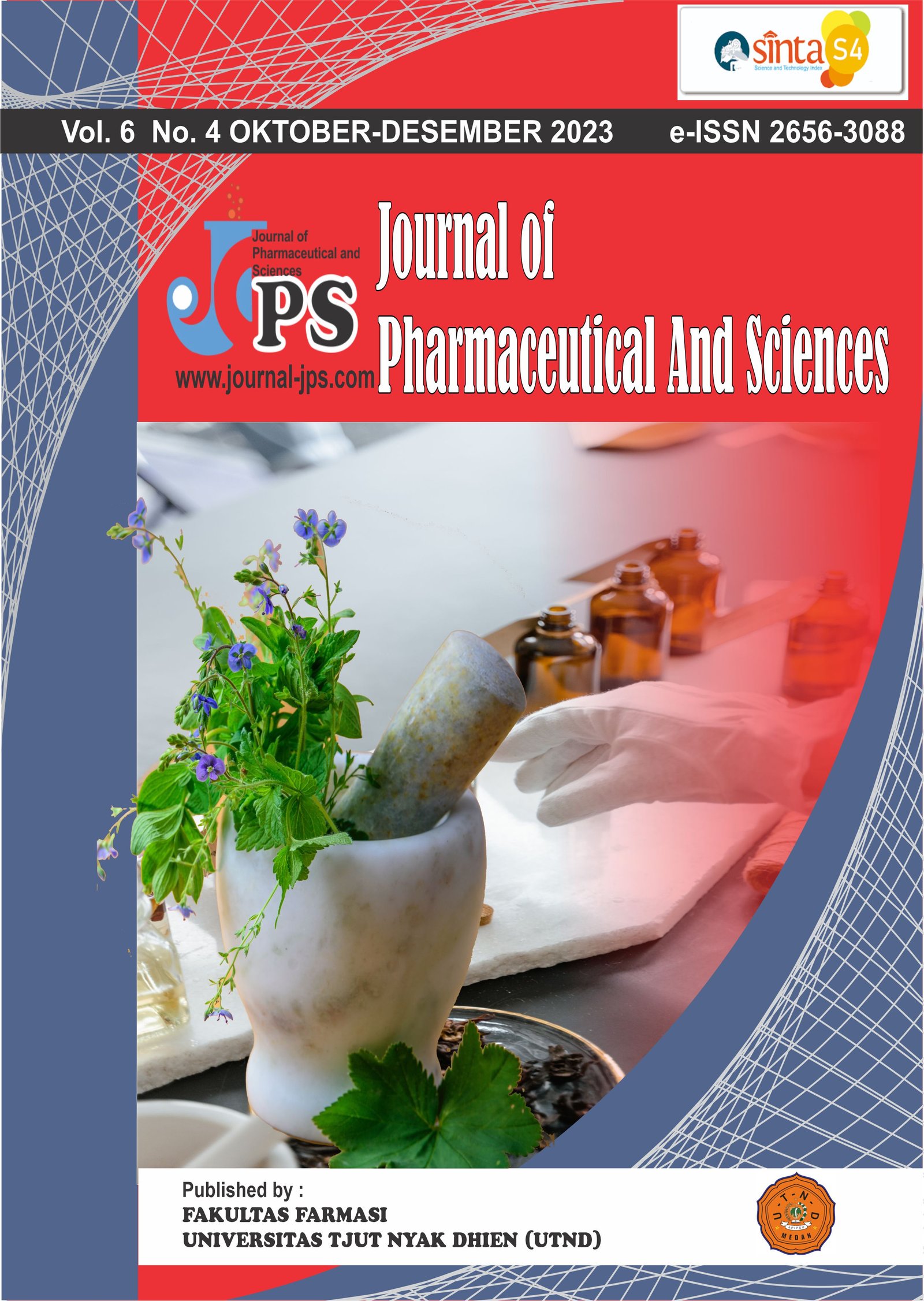Antibacterial activity test of the n-hexane and ethyl acetate fraction of kecombrang leaf(Etlingera elatior) against Staphylococcus aureus and Escherichia coli
Main Article Content
Page: 1488-1497
Abstract
Infectious diseases caused by microorganisms are diseases that are commonly found in society. The therapy used to treat infections today by administering antibiotics. However, many cases of bacterial resistance to antibiotics are caused by the irrational use of antibiotics, so is necessary to develop alternatives to antibiotics derived from plants. glycosides that can function as antimicrobials. This study aims to determine the activity of the n-hexane and ethyl acetate fractions from kecombrang leaves against Staphylococcus aureus and Escherichia coli. This research was conducted experimentally, the independent variables consisted of the ethanol extract of kecombrang leaves, n hexane and ethyl acetate fractions. The dependent variable consisted of simplicia characteristic test, kecombrang leaf phytochemical screening, antibacterial activity test of kecombrang leaf fraction against S.aureus and E.coli. Antibacterial test using n-hexane and ethyl acetate fractions made with concentrations of 10%, 30%, 50% and 70%. the positive control used the antibiotic chloramphenicol and the negative control used DMSO, and the method used was agar diffusion using paper discs.The results of the antibacterial test showed that kecombrang leaves had an inhibitory effect on Staphylococcus aureus and Escherichia coli bacteria. The inhibition power of the ethyl acetate fraction was stronger than n hexane. The strongest inhibition was found in the ethyl acetate fraction with a concentration of 30.50 and 70% against Staphylococcus aureus, namely 10.9 mm, 12.6 mm and 14.15 mm. whereas in Escherichia coli bacteria, namely 10.5 mm, 12.3 mm. and 13.9mm. and based on the CLSI inhibition zone category, 2020, the concentration fraction of 70% is in the intermediate category, concentrations of 50, 30, and 10% are in the resistant category. While the positive control is categorized as sensitive to both bacteria.
Downloads
Article Details

This work is licensed under a Creative Commons Attribution-NonCommercial-ShareAlike 4.0 International License.
References
Bassett, J., Denney, R. C., Jeffrey, G.H., dan Mendham, J. (1994). Buku Ajar Vogel: Kimia Analisis Kuantitatif Anorganik. Edisi 4. Jakarta: EGC: Hal.165.
Depkes RI. (1979). Farmakope Indonesia Edisi III. Jakarta: Departemen Kesehatan RI.
Depkes RI. (1989). Materia Medika Indonesia. Jilid V. Jakarta: Departemen Kesehatan RI.
Ditjen POM. (1985). Cara Pembuatan Simplisia. Cetakan Pertama. Jakarta: Departemen Kesehatan RI.
Eko,S.,Risa.,dan Reza.R. (2015). Uji Aktivitas Antibakteri Ekstrak Etanol Daun Kecombrang (Etlingera elatior) Terhadap Bakteri Salmonella Thypi. Jurnal Ilmiah Manuntung.Vol 1.
Fardiaz, S. (1989). Mikrobiologi Pangan.PAU Pangan dan Gizi Institut Pertanian. Bogor.
Farsnworth, N.R. (1996). Biological and Phytochemical Screening of Plant.Journal of Pharmaceutical Sciences. 55-59
Harborne, J.B. (1987). Metode Fitokimia Penuntun Cara Modern Menganalisis Tumbuhan. Bandung: ITB Press.
Jones.,W.P., Kinghom,A.D.(2006).Extraction Of Plant Secondary Metabolites in Sharker Natural Product Isolation.Humana Press.New Jersey..
Kusumawati,Eko.,Risa.S.,dan Reza.R.(2015).Uji Aktivitas Antibakteri Ekstrak Etanol Daun Kecombrang Etlingera elatior (Jack) R.M Sm Terhadap Salmonella thypi.Jurnal Ilmiah Manuntung.vol1.Halaman 1-7.
Maulana,A.R.,Bawon,T.,,Hidayat.(2021).UjiAktivitas Antibakteri Ekstrak Etanol Daun Waru Gunung (Hibiscus macrophyllus) dan Fraksinya terhadap Staphylococcus aureus.Jember: e-Journal Pustaka Kesehatan,vol.9 (no.1).Halaman 49.
Nasution, H. M. (2020). Skrining Fitokimia dan Isolasi Senyawa Steroid/Triterpenoid dari Ekstrak N-Heksana Rumput Laut. Jurnal Dunia Farmasi.
Nasution,H.M,dkk.(2022).Phytochemical Screening and Antibacterial Activity Test Of Ethanol Extract Of Jengkol leaves (Archidendron Pauciforum Benth) I.C Nielsen Against Staphylococcus epidermidis and Propionibacterium acnes.International Journal Of Science.Halaman 650.
Rahmawati,(2014). Interaksi Ekstrak Daun Lidah Buaya (Aloe vera L) dan Daun Sirih (Piper betle) Terhadap Daya Hambat Staphylococcus aureus secara in vitro. Jurnal Edubio Tropika Vol 2. Halaman 121.
Robinson, T. 1995, Kandungan Organik Tumbuhan tinggi.ITB Press, Bandung. hal 191.
Salni,dkk.(2011).Isolasi Senyawa Antibakteri dari Daun Jengkol (Pithecolobium lobatum) dan Penentuan Nilai KHM nya.Sumatera Selatan:Universitas Sriwijaya.
Suryati, N., Bahar, E., and Ilmiawati, (2017). Uji efektifitas antibakteri ekstrak Aloe vera terhadap pertumbuhan Escherichia coli secara in vitro. Jurnal Kesehatan Andalas. Vol. 6, No.3: 518-522.
Syalsabila,Putri.,Nasution.H.M.,Daulay.A.S. (2023).Uji Aktivitas Antibakteri Ekstrak Etanol Daun Mahkota Dewa (Phaleria macrocarpa (Scheff)Boerl) Terhadap Propionibacterium acnes.Jurnal Farmasainkes.Vol2 No.2.Halaman 204.





